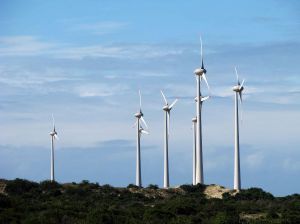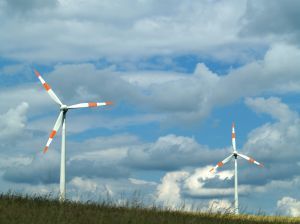Windmill can be defined as a machine which is powered by the energy of the wind. The latest applications of windmills include water pumping for stock and domestic supplies as well as electricity generation. The basic windmill has a tower, wind wheel, drive mechanism and a positive displacement pump. The rotational motion of mechanical wings is transmitted through the velocity panel to the generator which produces the energy of electricity. This energy is used to rotate the electricity engines, heating and lighting or delivered to the general electricity energy system. Recent electricity generation versions are referred to as wind turbines.

Windmill is an attractive electricity generation option due to low maintenance and ability to function unattended for long periods of time. In order, to find out whether the windmill can be located in a particular area, it is essential to obtain accurate wind speed data which is available on wind maps or from the local meteorology office. It is practical to locate a windmill as close as possible to the water source, and with good exposure to the wind. A good site is an open area with at least 400 meters of clear space around the windmill. Windmills can be built even in isolated areas; the great thing is that windmills have no energy costs. Windmills also have a few disadvantages, including the required auxiliary storage, high capital costs as well as the intermittent pumping in very light winds.

According to the wind wheel's shaft orientation in the space, windmills are divided into horizontal-shaft windmills and vertical-shaft windmills. Horizontal-shaft windmills are fast-moving, smaller in weight, whereas the cost of one installed kilowatt is normally smaller than the one of vertical-shaft windmill. The main parts of horizontal-shaft wind mill are the wind wheel, velocity panel, generator, casing and windmill towers. The windmill can consist of a different number of arms and rotate in a varying or constant velocity. The most popular wind mills are the ones with two or three arms.
When it comes to vertical-shaft windmills, even the ones of a simple construction, it is important to mention than these have quite a few disadvantages. They are slow-moving, take lots of space, whereas the use of the wind wheels is not higher than 18 percent. The main advantage of vertical wind wheels is the fact that the orientation system for wind direction is not needed; the important element of the windmills, such as velocity panel and generator can be fixed on the base of the windmill.
The wind wheel of the windmill which rotates in a varied velocity help to get a better use of the wind energy; however its interconnection into the electricity system is quite complicated. Though, it is possible to use the constant current generator or inverter which converts the constant current into a constant frequency current. However, due to the large space of generators and other disadvantages, such scheme is not practically applicable in large power windmills. Synchronous electricity current generators are being used according to the scheme as follows: varying frequency current - constant current - constant frequency current or mechanical, electricity managed devices which help to obtain the constant rotation velocity of the generator and the constant frequency of the varying current. For this reason, the turning angle of the wind wheel's arms is being changed. When the wind velocity increases, the wind wheel is being stopped, when it decreases, it is being accelerated. Various mechanical and aerodynamic stopping devices ensure the constant rotation of the windmill impeller.
Thus, windmill is a great alternative if unattended pumping is required for long periods, there is no other viable power source and the user requires environmentally clean power.
